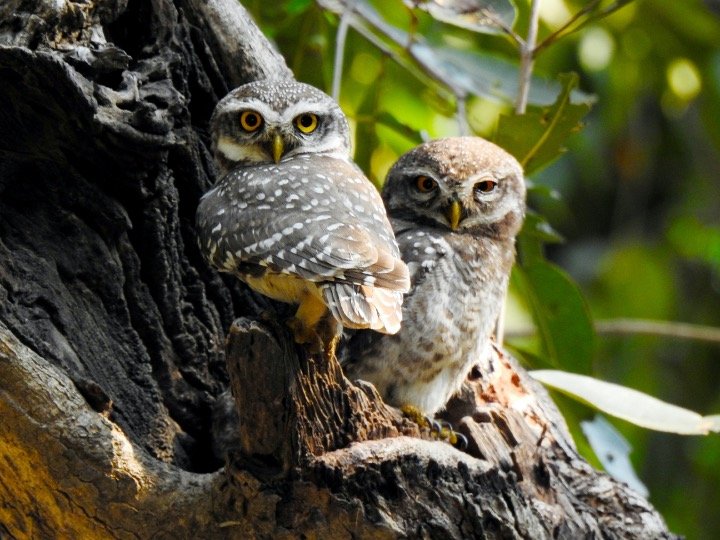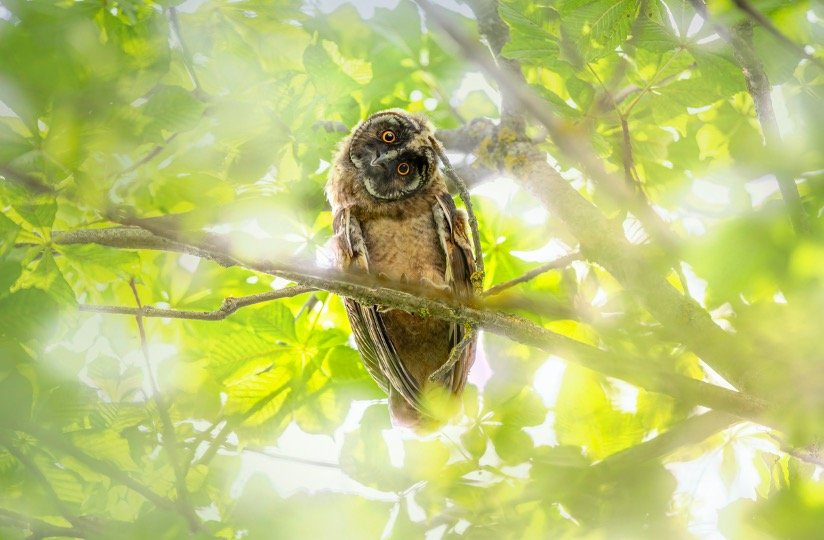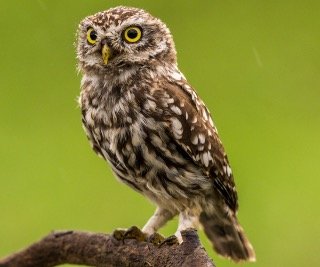
Are Owls Nocturnal?
Yes, owls are generally thought to be nocturnal creatures. This means that they are active at night and sleep during the day. Owls have a number of adaptations that allow them to hunt and navigate in the dark, such as excellent low-light vision, acute hearing, and silent flight.
However, some owl species, such as the snowy owl and the burrowing owl, are active during the day. These diurnal owls have adapted to hunting during the day and may rely less on their night vision and hearing.
Are All Owls Nocturnal?
No, not all owls are active at night. While most owl species are nocturnal, meaning they are active at night, some owl species are diurnal, meaning they are active during the day.
The burrowing owl, which is native to North and South America, and the snowy owl, which is found in the Arctic, are two examples of diurnal owl species. These owl species have adapted to hunting and living during the day, with characteristics such as keen eyesight and hearing that allow them to locate prey in broad daylight.
The vast majority of owl species are nocturnal, but there are a few exceptions in the form of diurnal owls.

List of Nocturnal Owls
Here is a list of some nocturnal owl species:
- Barn owl (Tyto alba)
- Tawny owl (Strix aluco)
- Great horned owl (Bubo virginianus)
- Snowy owl (Bubo scandiacus)
- Barred owl (Strix varia)
- Eastern screech-owl (Megascops asio)
- Long-eared owl (Asio otus)
- Short-eared owl (Asio flammeus)
- Northern saw-whet owl (Aegolius acadicus)
- Spectacled owl (Pulsatrix perspicillata)
List of Diurnal Owls
- Northern Hawk Owl (Surnia ulula)
- Burrowing Owl (Athene cunicularia)
- Northern Pygmy Owl (Glaucidium californicum)
- Short-eared Owl (Asio flammeus)
- Striped Owl (Pseudoscops clamator)
List of Crepuscular Owls
- Long-eared Owl (Asio otus)
- Northern Saw-whet Owl (Aegolius acadicus)
- Eastern Screech Owl (Megascops asio)
- Boreal Owl (Aegolius funereus)
- Tawny Owl (Strix aluco)

Why Owls are Nocturnal?
Owls are nocturnal for a variety of reasons, including:
1. Hunting: Owls are predators, with small mammals, birds, and insects as their primary prey. They can take advantage of the darkness to surprise and catch their prey more easily by being active at night. Owls have several adaptations that allow them to be effective night hunters, including exceptional low-light vision, acute hearing, and silent flight.
2. Competition: Other predators that are active during the day, such as hawks and eagles, pose a significant threat to owls. Owls can reduce competition for resources and avoid confrontations with diurnal predators by being active at night.
3. Avoiding predators: Larger predators such as coyotes and foxes, which are active during the day, may prey on owls. Owls can avoid these predators and reduce their chances of being attacked by being active at night.
4. Energy conservation: Due to their relatively large bodies and wingspans, owls must conserve energy during the day in order to fly and hunt efficiently at night. Owls can save energy for the more energy-intensive activities of hunting and flying at night by resting during the day.
What are Nocturnal Owl?
Nocturnal owls are a group of owl species that are active at night and sleep during the day. These owls have several adaptations that allow them to hunt in the dark effectively. They have excellent low-light vision and acute hearing, for example, allowing them to locate prey by sound.
They can also fly almost silently, allowing them to approach their prey without being detected.The great horned owl, barn owl, and snowy owl are examples of nocturnal owl species.

What are Diurnal Owls?
Diurnal owls are a type of owl that is active during the day and sleeps at night. They frequently have lighter-colored feathers, for example, that blend in with their surroundings and provide better camouflage during the day. They also have a more prominent facial disc, which aids in sound focus and prey detection.
The burrowing owl, short-eared owl, and northern pygmy owl are examples of diurnal owl species. These owls are frequently found in open habitats such as grasslands, deserts, and tundra, and they are well adapted to life in these environments.
What are Crepuscular Owls?
Crepuscular owls are a group of owl species that are most active at dawn and dusk, when the light is dim. They have excellent low-light vision and acute hearing, for example, allowing them to locate prey by sound.
The eastern screech owl, northern saw-whet owl, and long-eared owl are some crepuscular owl species. These owls are frequently associated with forests and wooded areas.
Nocturnal vs Diurnal Owls
The primary distinction between nocturnal and diurnal owls is their activity pattern. Nocturnal owls are active at night and sleep during the day, whereas diurnal owls are active during the day and sleep at night.
Are Snowy Owls Nocturnal?
Snowy owls (Bubo scandiacus) are thought to be diurnal or crepuscular rather than nocturnal. While they are most active during the day, they may hunt and be active at dawn and dusk as well.
Snowy owls are well-adapted to hunting in bright daylight, and their excellent eyesight and hearing enable them to locate prey even in low-light conditions.
Snowy owls may become more nocturnal during the breeding season, hunting and foraging primarily at night to avoid the high temperatures and intense sunlight of the Arctic summer days.

Are Barn Owls Nocturnal?
Barn owls (Tyto alba) are nocturnal birds, which means they are mostly active at night and sleep during the day. Barn owls have several adaptations that enable them to hunt effectively in the dark, including excellent low-light vision and acute hearing that allows them to locate prey through sound.
They can also fly almost silently, allowing them to sneak up on their prey without being noticed. Barn owls are known to begin hunting at dusk and may hunt throughout the night until dawn.
They typically roost during the day in dark and sheltered locations, such as tree hollows, barns, or other structures, where they can rest and conserve energy for the following night’s hunting.
Are Great Horned Owls Nocturnal?
Yes, great horned owls (Bubo virginianus) are primarily nocturnal birds, meaning they spend the majority of their time awake at night and sleeping during the day.
Great horned owls typically begin their nightly hunting activities shortly after dusk and may hunt until dawn. During the day, they may roost in trees or other elevated locations, blending in with their surroundings and avoiding detection by predators or other potential threats.
Are Barred Owls Nocturnal?
Yes, barred owls (Strix varia) are primarily nocturnal birds, meaning they spend the majority of their time awake at night and sleep during the day. Barred owls typically start hunting shortly after dusk and can hunt all night long until dawn.
During the day, they may roost in trees or other elevated locations, blending in with their surroundings and avoiding detection by predators or other potential threats. However, barred owls have been observed hunting during the day, especially during the breeding season when they need to feed their young.

Are Burrowing Owls Nocturnal?
No. Burrowing owls (Athene cunicularia) are thought to be diurnal or crepuscular rather than nocturnal. They are most active during the day, but they may also be active at dawn and dusk. Burrowing owls live in underground burrows that they dig or that other animals, such as prairie dogs, take over.
During the day, they spend a lot of time near the entrance of their burrow, keeping an eye out for predators and other threats. They sleep in the safety of their burrow at night. They may, however, be more active at night during the hottest times of the year to avoid the high temperatures of the day.
Are Eastern Screech Owls Nocturnal?
Eastern screech owls (Megascops asio) are nocturnal birds, which means they are most active at night and sleep during the day. However, like other owl species, they can vary their activity patterns according to their environment and the demands of their life cycle.
Eastern screech owls typically begin hunting shortly after dusk and may hunt through the night until dawn. During the day, they may roost in trees or other elevated locations, blending in with their surroundings and avoiding detection by predators or other potential threats.
Are Little Owls Nocturnal?
Yes, little owls (Athene noctua) are nocturnal birds, which means they are most active at night and rest during the day. Little owls are known to be active during the day, especially during the breeding season when they need to feed their young.
Little owls are highly adapted to a nocturnal lifestyle, but their activity patterns can vary depending on their environment and the demands of their life cycle.
What Exactly Are Owls?
Owls are members of the Strigiformes family of birds. This group is made up of around 200 birds of prey(most of whom are solitary), who are alert and sharp in their hunting. Owls have huge eyes with binocular vision, and their heads can rotate a maximum of 270 degrees, making them excellent hunters.
The Blakiston fish owl is the largest owl in the world, and it is also one of the most endangered. These birds can grow to have wingspans of up to 6 feet, stand 28 inches tall, and weigh up to 10 pounds in their adulthood.
The elf owl is the tiniest of all the owls, with a wingspan of about 10.5 inches, standing approximately 5.5 inches tall, and weighing only 1.4 ounces. It is the smallest of all the owls. As you can see, there seems to be a variety of sizes available.
What is a Group of Owls Called? Everything You Need To Know
What they lack in color, however, is what they make up for in size variance. The majority of owls are in neutral colors, ranging from virtually black to snow white in hue.

What Do Owls Consume?
Owls are carnivorous, which means that whether they are nocturnal (at night) or diurnal (during the day), they require meat to sustain their existence. The variety of wildlife that these opportunistic eaters can eat depends on their region and species, but they can munch on anything.
In general, owls consume the following foods:
• Rodents
• Reptiles
• Smaller birds
• Insects
Depending on the size of the prey, owls may be able to swallow small animals head first in their mouths. Any bones that the owls are unable to consume are regurgitated in the form of pellets.
What Causes the Greatest Number of Owls to Be Nocturnal?
Owls are ruthless predators who never give up. The majority of the time, they capture prey before they have a chance to respond. Being nocturnal is extremely useful to owls because it allows them to take advantage of their excellent vision and silent flying, which is quite beneficial for hunting.
Baby Owls: Everything You Need To Know (With Pictures)
Their razor-sharp beaks can rip flesh in seconds, and their brutally strong talons can grasp prey in a matter of seconds. Although some owls hunt at night, depending on where they reside, it may not be as advantageous for certain of them to do so, resulting in adaptations.

Nocturnal vs Diurnal vs Crepuscular: Which is Better?
Despite the fact that the vast majority of owl species are nocturnal, many species are also crepuscular in their behavior (both day and night). Two species are totally diurnal, making up the tiniest subset of the entire group.
Even nocturnal owls remain on the lookout during daylight hours in case any hazards are in the neighborhood. It’s interesting to note that the hue of an owl’s eyes can tell you what time of day they’re most active.
Nocturnal Owls
Approximately 70 percent of owls are thought to be nocturnal. Nocturnal owls have dark pupils. These owls are constructed for stealthy night hunting, and their keen eyesight allows them to spot prey at a distance.
The following are examples of nocturnal owls:
• Great horned owl
• Barn owl
• Northern spotted owl
• Barred owl
Diurnal Owls
It is thought that only 3% of owls are active during the day. The eyes of diurnal owls are yellow. The pygmy owl and the northern hawk owl are the only two species of owl that are genuinely diurnal.
Do Owls Hibernate or Migrate? Everything You Need To Know
Throughout North America and Asia, northern hawk owls can be found. When it comes to hunting, they have a style that is comparable to that of hawks and falcons. They keep a close eye on their prey from high perches or even while in mid-flight.
Throughout North America, pygmy owls can be found on the West Coast. They are swift and effective in flight, often grabbing their prey in the middle of the flight.

Crepuscular Owls
Crepuscular owls account for around 22% of the total population. Crepuscular owls have orange eyes, which distinguish them from other owls. Crepuscular owls hunt at dusk and dawn, when the sun has not yet fully set or risen in full.
Crepuscular owls comprise the following species:
• Snowy owls
• Short-eared owls
• Burrowing owls
• Eurasian eagle owls
• Great gray owls
Unknown Owls
Owls have a reputation for being extremely secretive. In this area, there is a 6% margin of uncertainty due to an unknown cause, which means that scientists just do not have enough evidence to know for certain.
Are Owls Smart? It’s NOT What You Think
In the future, as scientists and researchers get the opportunity to study owls in their natural environments, we will have a better understanding of them.
No matter what time of day an owl species prefers to hunt, they all take advantage of their free time to rest and replenish their energy stores after a hard day of hunting.

Take Away Message
Despite the fact that most owls are nocturnal, they can be found out and about at any time of day, depending on the species. Despite the fact that most owls prefer to hunt at night, the color of an owl’s eyes can tell you what time of day it is when it is out hunting.
Keep in mind that dark eyes indicate nocturnal, orange eyes indicate crepuscular, and yellow eyes indicate diurnal. So, the next time you see a picture of an owl, you’ll be able to share its details with your social circle.








